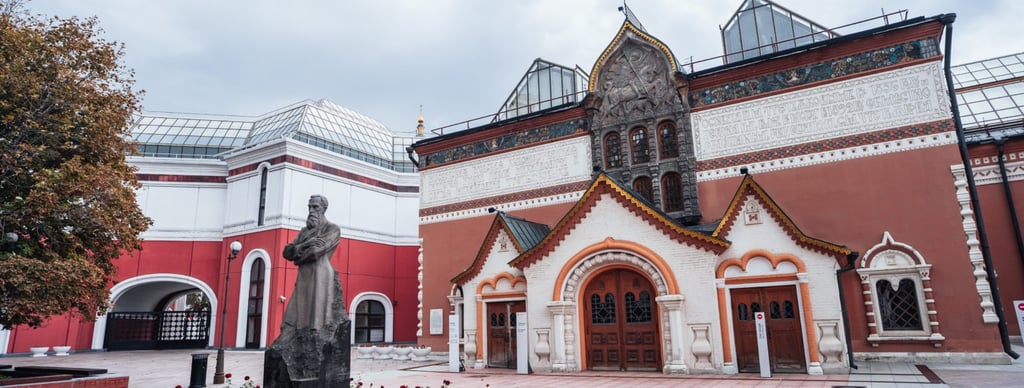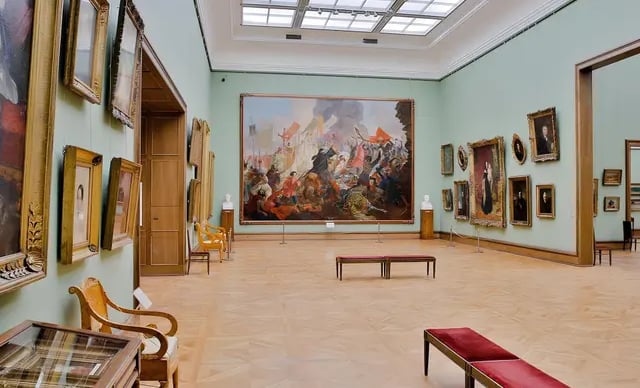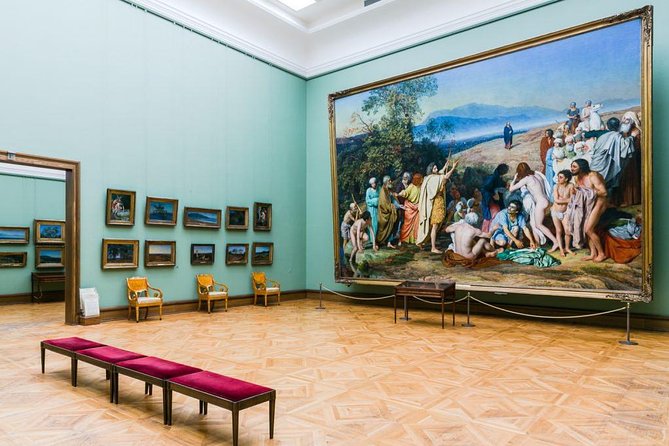Tretyakov Gallery: Where the Soul of Russia Is Painted in Every Stroke
Step into the timeless halls where Russia’s heart beats on canvas — a gallery where centuries of dreams, struggles, and spirit live in the eyes of painted faces and the sweep of bold landscapes.


The Birth of a National Treasure
The Tretyakov Gallery is more than a museum. It is a living, breathing embodiment of Russian identity — a place where the nation’s memory is preserved in oils and pastels, in marble and bronze. Nestled on a quiet street in the historic Zamoskvorechye district of Moscow, this institution was born not from the state but from the heart of a single man: Pavel Mikhailovich Tretyakov.
A successful textile merchant with a profound love for Russian art, Tretyakov began collecting works in the mid-19th century with a singular, noble vision: to create a museum of national art accessible to the public. His dream was to foster Russian creativity and give the people a mirror in which to see their own evolving soul.
In 1892, Tretyakov donated his vast collection — more than 2,000 works — along with the gallery building itself, to the city of Moscow. Thus, the Tretyakov Gallery became the first major public art museum in Russia dedicated solely to Russian artists.
Today, the collection has grown to over 180,000 works, spanning a thousand years of Russian visual culture. Every brushstroke whispers stories of emperors and peasants, revolutionaries and dreamers, saints and sinners.
A Journey Through Russian Art
To walk through the Tretyakov Gallery is to journey through Russia’s history, heart, and imagination. The gallery’s chronological layout sweeps visitors across the ages, beginning with medieval icons and culminating in the vibrant avant-garde of the early 20th century.
The Icons: Light of the Ancient Faith
The first rooms of the gallery glow with the mystical luminosity of Russian Orthodox icons. Here you find works by legendary iconographers such as Andrei Rublev, whose Trinity is a masterpiece of spiritual vision and harmonious composition. Painted in the early 15th century, this icon radiates peace and unity, embodying the sacred ideals of Russian Orthodoxy.
Standing before these icons, one is transported to a world where art served as a bridge between the earthly and the divine. The gold leaf shimmers like the light of eternal hope; the stylized figures of saints seem almost to breathe within their wooden frames.
The 18th and Early 19th Centuries: The Birth of Russian Portraiture
As you progress, the gallery opens onto the elegant world of 18th-century Russian portraiture. Under the patronage of the Tsars, Russian artists began to master European techniques while developing a distinctly national voice.
Here are the grand portraits of Dmitry Levitsky and Vladimir Borovikovsky, capturing the aristocracy in powdered wigs and flowing silks. Yet beyond the finery, the painters convey a uniquely Russian introspection — a subtle melancholy behind the poised gazes.
Karl Bryullov’s monumental The Last Day of Pompeii is another showstopper of this period — a dazzling fusion of classical drama and Romantic emotion. With swirling smoke, desperate figures, and an apocalyptic atmosphere, the painting is a tour de force of narrative art.
The Wanderers: Realism and the Russian Soul
At the heart of the Tretyakov Gallery lies the art of the Peredvizhniki, or Wanderers — a group of 19th-century realist painters who sought to portray the true life of the Russian people.
Rejecting the academic conventions of the Imperial Academy, the Wanderers traveled across Russia’s vast landscapes, capturing peasants at work, stark rural poverty, and the majesty of nature. Their paintings pulse with compassion, social conscience, and national pride.
Here, the visitor encounters the piercing gaze of Ilya Repin’s portraits and historical canvases. His Barge Haulers on the Volga is an unflinching depiction of human suffering and endurance, while Ivan the Terrible and His Son freezes a moment of tragic madness in harrowing psychological detail.
Vasily Surikov’s sweeping historical epics, such as Boyarina Morozova, convey the drama and tragedy of Russia’s past. Isaac Levitan’s haunting landscapes — melancholic rivers, mist-draped forests — evoke the soul of the Russian land itself.
One cannot leave this section untouched. These works speak directly to the heart, resonating across the centuries.
Symbolism and the Silver Age
As the 19th century gave way to the early 20th, Russian art entered a mystical, symbolic phase known as the Silver Age. Poets, painters, and philosophers sought to transcend realism, reaching toward the metaphysical.
In these rooms, the visionary works of Mikhail Vrubel, with their jewel-like colors and demonic beauty, shimmer with an otherworldly intensity. His Demon Seated is a masterpiece of tortured grace and spectral melancholy.
Victor Vasnetsov’s folkloric paintings transport viewers into the realm of Russian fairy tales and epic legends — images that shaped the childhood dreams of generations.
The Avant-Garde and Revolution
The final chapters of the gallery’s story chart the explosive birth of the Russian avant-garde. Here, the visitor encounters the radical geometries of Kazimir Malevich, the swirling dynamism of Natalia Goncharova, and the bold abstractions of Wassily Kandinsky.
These revolutionary artists shattered artistic conventions in pursuit of new forms of expression. In the wake of the 1917 Revolution, art itself became a battleground for competing visions of Russia’s future.
A Temple of Memory
The Tretyakov Gallery is more than an art museum — it is a temple of memory. To wander its halls is to witness Russia dreaming, struggling, yearning. Each canvas offers a window into the nation’s evolving consciousness.
The gallery’s architecture reinforces this experience. Its fairytale façade, crowned by the distinctive Abramtsevo-style gable designed by painter Viktor Vasnetsov, welcomes visitors like an enchanted gateway. Inside, the softly lit rooms invite contemplation, reverence, and awe.
The crowds that fill the Tretyakov — schoolchildren clutching notebooks, elderly Muscovites revisiting old favorites, tourists marveling at unfamiliar masterpieces — testify to its enduring role as a beloved public institution. Here, art is not the preserve of an elite. It belongs to all.
Pavel Tretyakov’s Enduring Legacy
At the heart of this grand institution remains the spirit of its founder. Pavel Tretyakov believed passionately in the transformative power of art. He saw Russian painters not as mere decorators of aristocratic salons but as voices of the people, chroniclers of national life.
His vision lives on. The gallery continues to expand its collection, support living artists, and foster public appreciation of Russian art. Its educational programs, exhibitions, and international collaborations ensure that Tretyakov’s gift continues to inspire new generations.
In a world where many public institutions trace their origins to imperial command or state decree, the Tretyakov Gallery is a rare testament to private passion and civic generosity. It stands as a monument to the idea that one individual’s love of art can shape an entire nation’s cultural life.
The Magic of the Tretyakov Experience
To stand before Andrei Rublev’s Trinity, to lose oneself in the mournful eyes of Repin’s peasants, to be dazzled by Vrubel’s spectral visions — this is the magic of the Tretyakov Gallery.
It is a place where the pulse of Russia is painted in every stroke. Where history breathes through pigments and canvas. Where the individual and the collective, the sacred and the profane, the past and the future, all meet in luminous dialogue.
Here, in this sanctuary of art, one feels the profound truth of the Russian proverb: "Art is not a mirror to reflect the world, but a hammer with which to shape it."
Practical Information
Location
The main building of the Tretyakov Gallery is located at:
Lavrushinsky Lane 10, Moscow, Russia
The New Tretyakov Gallery is located at:
Krymsky Val 10, Moscow, Russia
Opening Hours
Main Tretyakov Gallery:
Tuesday — Sunday: 10:00 — 18:00
Closed on Mondays
New Tretyakov Gallery:
Tuesday — Sunday: 10:00 — 21:00
Closed on Mondays
Tickets
Tickets can be purchased online or at the gallery. Combination tickets are available for access to both the Main and New Tretyakov galleries. Concessions apply for students, seniors, and certain categories of Russian citizens.
Guided Tours
The gallery offers guided tours in Russian and other languages. Audio guides and educational programs are also available.
Accessibility
Both gallery buildings are equipped for visitors with reduced mobility. Additional services are available for visually and hearing-impaired guests.
Café and Museum Shop
Visitors can enjoy refreshments at the on-site café and browse a wide selection of books, art prints, and souvenirs at the museum shop.
Public Transport
The Main Tretyakov Gallery is easily accessible by metro:
Tretyakovskaya station (Line 6 and 8).
The New Tretyakov Gallery is served by:
Oktyabrskaya metro station (Line 5 and 6).
For the latest information on exhibitions, tickets, and programs, visit the official website:
https://www.tretyakovgallery.ru


The Living Collection
The Tretyakov Gallery is not frozen in the past. Its collection continues to grow, and its mission remains vibrant and evolving. In addition to the historical galleries housed at the original Lavrushinsky Lane building, the museum operates a dynamic New Tretyakov Gallery on Krymsky Val, devoted to Russian art of the 20th and 21st centuries.
This modern wing presents the evolution of Russian art through the tumultuous 20th century: the optimism of early Soviet avant-garde, the heroic realism of Socialist Realism, the underground art of the non-conformists, and the bold innovations of contemporary Russian artists.
Here, visitors encounter Malevich’s stark Black Square, a work that revolutionized modern art, alongside monumental canvases extolling Soviet industry and idealism. The halls also showcase Tatlin’s visionary architectural models, Kandinsky’s spiritual abstractions, and the daring works of Oskar Rabin and other dissident artists.
Today, the New Tretyakov is a laboratory of creativity, hosting contemporary exhibitions, multimedia installations, and cross-disciplinary collaborations that keep Russian art at the forefront of global dialogue.
Treasures and Highlights
Among the countless treasures of the Tretyakov Gallery, a few works stand out as iconic — essential encounters for any visitor.
Andrei Rublev’s Trinity: Often regarded as the pinnacle of Russian icon painting, this transcendent work radiates harmony and spiritual grace.
Ilya Repin’s Ivan the Terrible and His Son: A painting of shattering emotional power, capturing a father’s remorse and a son’s death in haunting detail.
Isaac Levitan’s Above Eternal Peace: A landscape that distills the somber beauty of the Russian soul in a vision of church, water, and endless sky.
Viktor Vasnetsov’s Bogatyrs: Three colossal warriors of Russian legend, immortalized in heroic grandeur.
Mikhail Vrubel’s Demon Seated: A mesmerizing portrayal of existential anguish and spectral beauty.
Kazimir Malevich’s Black Square: A cornerstone of abstract art, embodying a radical break from figurative tradition.
Each of these works — and countless others — offers a window into the Russian experience, inviting contemplation and dialogue across time.
A Pilgrimage for Art Lovers
Visiting the Tretyakov Gallery is a pilgrimage for art lovers, historians, and anyone seeking to understand the Russian soul. The experience is immersive, moving, and intellectually enriching.
The gallery’s layout facilitates deep engagement. Thoughtfully curated rooms guide visitors through artistic epochs and movements, while wall texts and multimedia guides provide rich context. Regular temporary exhibitions bring fresh perspectives and international collaborations.
For those unable to visit in person, the gallery offers a wealth of virtual tours and online resources, making its treasures accessible worldwide.




